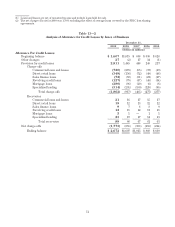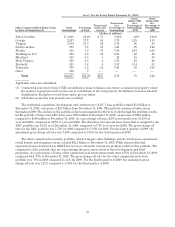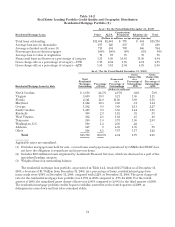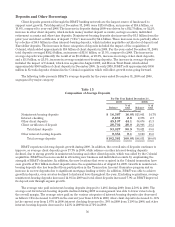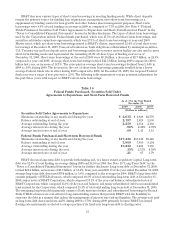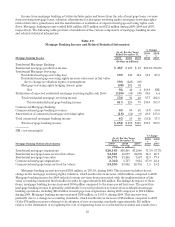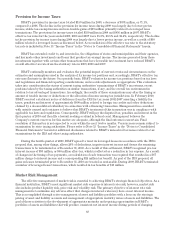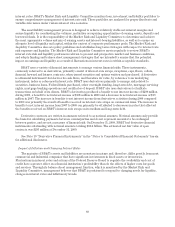BB&T 2009 Annual Report Download - page 61
Download and view the complete annual report
Please find page 61 of the 2009 BB&T annual report below. You can navigate through the pages in the report by either clicking on the pages listed below, or by using the keyword search tool below to find specific information within the annual report.
Provision for Credit Losses
A provision for credit losses is charged against earnings in order to maintain an allowance for loan and lease
losses and a reserve for unfunded lending commitments that reflects management’s best estimate of probable
losses inherent in the credit portfolios at the balance sheet date. The amount of the provision is based on
continuing assessments of nonperforming and “watch list” loans and associated unfunded credit commitments,
analytical reviews of loss experience in relation to outstanding loans and funded credit commitments, loan charge-
offs, nonperforming asset trends and management’s judgment with respect to current and expected economic
conditions and their impact on the loan portfolio and outstanding unfunded credit commitments. The methodology
used is described in the “Overview and Description of Business” section under the heading “Allowance for Loan
and Lease Losses and Reserve for Unfunded Credit Commitments.” The provision for credit losses recorded by
BB&T in 2009 was $2.8 billion, compared with $1.4 billion in 2008 and $448 million in 2007.
The provision for credit losses increased 94.5% during 2009 while total loans and leases held for investment
excluding covered loans declined 1.7% compared to the balance outstanding at the end of 2008. Net charge-offs were
1.74% of average loans and leases (or 1.79% excluding covered loans) for 2009 compared to .89% of average loans and
leases during 2008. The allowance for loan and lease losses was 2.51% of loans and leases held for investment (or
2.72% excluding covered loans) and was .96x total nonaccrual loans and leases at year-end 2009, compared to 1.62%
and 1.11x, respectively, at December 31, 2008. The increase in the provision for credit losses during 2009 compared
to 2008 was largely driven by ongoing challenges in residential real estate markets and the overall economy with the
largest concentration of credit issues occurring in Georgia, Florida, and metro Washington D.C., with some
deterioration in the coastal areas of the Carolinas. Additional disclosures related to BB&T’s real estate lending by
product type and geographic distribution can be found in Table 14 herein. The 222.5% increase in the provision for
credit losses during 2008 compared to 2007 was primarily the result of these same issues.
Noninterest Income
Noninterest income has become, and will continue to be, a significant contributor to BB&T’s financial success.
Noninterest income includes insurance income, service charges on deposit accounts, mortgage banking income,
investment banking and brokerage fees and commissions, trust and investment advisory revenues, gains and
losses on securities transactions, and commissions and fees derived from other activities. Noninterest income as a
percentage of total FTE revenues has steadily increased in recent years, totaling 44.2% for 2009. Excluding net
securities gains and a gain from the sale of BB&T’s payroll processing business, noninterest income was 42.8% of
total revenues in 2009. Exceeding 40% on this measure had been a management objective for several years.
Management has established a goal for noninterest income to exceed 45% of total revenues in the next few years
to further reduce BB&T’s reliance on traditional spread-based interest income, as fee-based activities are a
relatively stable revenue source during periods of changing interest rates.
The following table provides a breakdown of BB&T’s noninterest income:
Table 18
Noninterest Income
Years Ended December 31,
% Change
2009
v.
2008
2008
v.
20072009 2008 2007
(Dollars in millions)
Insurance income $1,047 $ 928 $ 853 12.8% 8.8%
Service charges on deposits 690 673 611 2.5 10.1
Mortgage banking income 658 275 115 139.3 139.1
Investment banking and brokerage fees and commissions 346 354 343 (2.3) 3.2
Other nondeposit fees and commissions 229 189 184 21.2 2.7
Checkcard fees 227 201 180 12.9 11.7
Bankcard fees and merchant discounts 156 151 139 3.3 8.6
Trust and investment advisory revenues 139 147 162 (5.4) (9.3)
Securities gains (losses), net 199 107 (3) 86.0 NM
Income from bank-owned life insurance 97 84 101 15.5 (16.8)
Other income 146 88 89 65.9 (1.1)
Total noninterest income $3,934 $3,197 $2,774 23.1 15.2
NM—not meaningful
61


